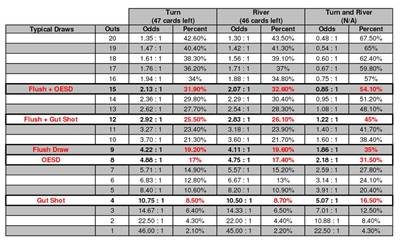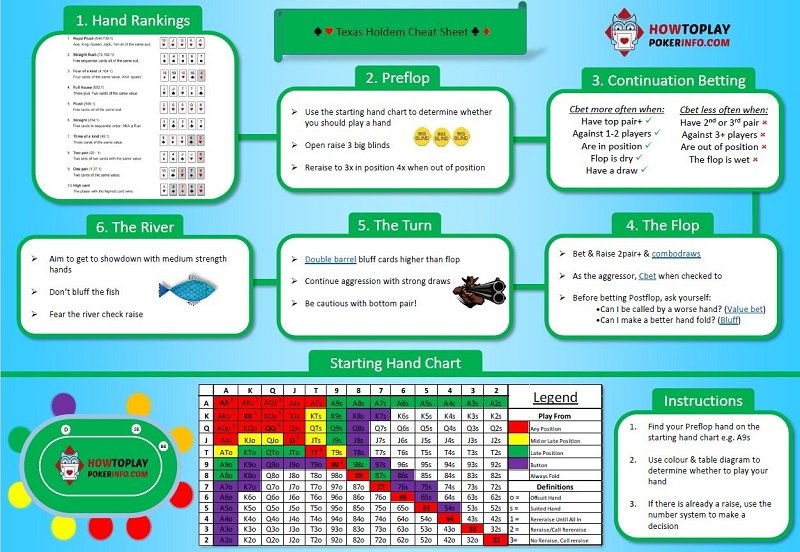How To Work Out Pot Odds In Texas Holdem
The most straightforward explanation of how to calculate pot odds is to compare the total number of unknown cards to how many outs you have, and then do some simple division. For example, if you are four to a nut flush on the turn of a Texas Hold 'em game, there are 46 unknown cards, (52 minus your 2 pocket cards and 4 on the board). The ability to calculate pot odds is a necessary part of Poker Mathematics and is used a lot by expert players to get an added advantage in a Texas Holdem Poker game. No matter whether you are playing at 10/40 table or the 100/500 table at our poker rooms, you will always find a player who is making bad pot odd decisions and paying for the same.
In Texas Hold’em, your goal is to build the best five-card hand according Texas Hold’em Poker hand ranking. The dealer gives each player two cards face down. These are known as the hole cards. The dealer than sets out five “community cards” face-up in the center. The first three of these are known as the flop, followed by the one-card “turn,” followed by the final card known as the “river.”
You can build your five-card hand using any combination of the hole and community cards. Along the way, players can fold, or take themselves out of the betting, if they don’t think that they have a chance of winning. If only one player is left after all betting and dealing has happened, that player wins. If not, players show their hands and the best hand wins.
“What are the Odds?” – Doing the Math
In poker, as in other games in which you bet on an outcome, odds give you a sense of how likely it is that your bet will win.
Example: You’re betting on a horse race. The booking agent tells you that one horse has odds of 5:1 and the other has odds of 12:1. That means that if you bet on the first horse and he wins, you’ll get $5 for every dollar that you bet. If you bet on the second horse, you’ll get $12 for every dollar bet.
You get more money for an unlikely win. A $10 bet on the second horse might win you $120, but you’re more likely to lose the $10. You have a better chance of betting $10 on the first horse and winning $50.
“It’s a long shot.”
An extremely unlikely win is known as a long shot. If the odds on a third horse are 50:1, you might be tempted to put in $10 and collect $500 – or even put in $100 and get $5,000.

Neither one of those outcomes has much chance of coming true.
What are Pot Odds?
In Texas Hold’em poker, pot odds specifically refer to the ratio between the size of the pot, or the amount of money on the table, and the size of your opponent’s bet. You use this ratio to determine whether to call a bet.
Example: There’s already $40 in the pot and your opponent bets $10. That puts a total of $50 in the pot. If you call the bet, you’re risking $10 of your own money.
Think of the pot odds as potential rewards relative to potential risk. In this case, you could get $50 for that $10 bet, so the pot odds are 50-to-10, which reduces to pot odds of 5 to 1.

Calculating Your Personal Odds
This basic definition of pot odds tells you how much you’re risking from a money perspective, but there’s more involved in whether you and your specific hand will win. If you can’t come up with a good hand using any of the cards available to you, your actual odds of winning are different than if you had four of the same card value to make four of a kind.
To figure out whether the pot odds are worth it for you, you need to figure out how many “outs” you have. That means calculating the number of cards that would help you win that are still in the deck.
Example: You have an ace and a six in your hand. Out of the four cards that the dealer has laid out, you see one more ace and another six. If you can get another ace or six, you’ll have a full house. That’s the fourth highest hand possible, so you decide to go for that.
Using Outs to Determine Odds
There’s always a chance that your opponent might be holding one of those outs, and you have to account for that when determining your odds. This is a two-step process. To illustrate it, let’s follow the above example of your quest for a full house.
Step 1: Determine how many cards you can’t see.
When there are two cards in your hand and four on the table, you can see six out of the 52 cards in the deck. You can’t see 52 minus six, or 46 cards. Two of those are in your opponent’s hand.
Step 2: Determine how many unseen cards will make you lose and how many will make you win.
You know there are four cards of each value in the deck. You have two aces and two sixes visible, which means you have four “outs” among the 46 unseen cards. Those four cards are likely to get you a win.
The remaining 42 cards will probably cause you to lose. (You’ll still have two pair, but that’s a fairly low hand, so you decide not to bank on it.)
Step 3: Set up the ratio of losing cards to winning cards.
If 42 cards mean a loss and four mean a win, your odds of winning the hand are 42 to 4, which reduces down to 21 to 2 or 10½ to 1.
A Note on Percentages
Some people prefer to work with percentages over ratios. That just involves a little bit more math.
All you have to do is add the two numbers and put the second number on top then multiply by 100. In this case, using our lowest whole-number ratio, that works out to 2/23*100, or 8.69 percent.
That means that you have an 8.69 percent chance of winning.
All you have to do is add the two numbers and put the second number on top then multiply by 100. In this case, using our lowest whole-number ratio, that works out to 2/23*100, or 8.69 percent.
That means that you have an 8.69 percent chance of winning.
Pot Odds, Personal Odds, and Your Decision to Call
In this scenario, the dealer is about to turn over the “river” card. You can use your odds of winning and the pot odds to decide whether it’s worth your while to call the bet and see that card. This involves three steps.

Step 1: How much do your odds say you’d win?
As we figured above, your odds are 10½ to 1. If you bet $10, you’d multiply that by 10 ½ and win $105.
Step 2: How much could you win and what are your monetary odds of getting it?
We established at the beginning of this process that your opponent’s $10 bet will make $50 in the pot. You could win $50 for your $10 bet, so the pot odds are 50:10 or 5:1.
Step 3: Should you call the bet?
How To Figure Out Pot Odds In Texas Holdem
Your personal chance of winning is 10½ to 1. By betting $10 and creating a pot of $50, your opponent is offering you 5 to 1 odds.
You’re playing with a long shot, but your chance of a payout doesn’t measure up. If you win and only had less than a 9 percent chance of it, you deserve more than a 5:1 payout.
Should you take those odds? Probably not. But if your personal odds of winning were more like 4:1 or even 3:1, then you’d want to call the bet because the pot odds would be higher.
The Four and Two Rule
In real-life games, you likely won’t have enough time to do all of these calculations, but you can calculate your outs fairly quickly.
Let’s assume the four outs we had in our full house example. If you’re deciding after the flop to call the bet, meaning that there are three cards on the table including your ace and six, multiply your outs by four. Your odds of getting a winning card are 4 x 4 or 16%.
If there are four cards dealt, multiply your outs by 2. Yours, in this situation, would be 4 x 2 or 8%.
You Win Some, You Lose Some
How To Work Out Pot Odds In Texas Holdem Texas Hold Em
Even if the ratio of personal odds to pot odds are in your favor, you’ll lose some rounds. Odds of 3:1, for example, mean that you’ll theoretically lose three times for every win.
That’s why you want the pot odds to be higher than your own odds. If the math works out, you’ll win more money than you lose.
Example: You play four hands, each of which gives you 3:1 odds. Your pot is still $50 each time and you call four $10 bets. You win $50 and lose $30, so you come out ahead at $20.
The Take-Away
If you have time during your hand of poker to do the long-form calculations, do it. Your odds will be more precise and you can make an informed decision. If not, go with the four and two rule, since that gives you a general idea of your likelihood of drawing a winning card.
How To Work Out Pot Odds In Texas Holdemin Texas Hold Em
Remember, the more comfortable you get calculating pot odds, the more you’ll be able to play poker as a game of skill rather than luck. Enjoy!